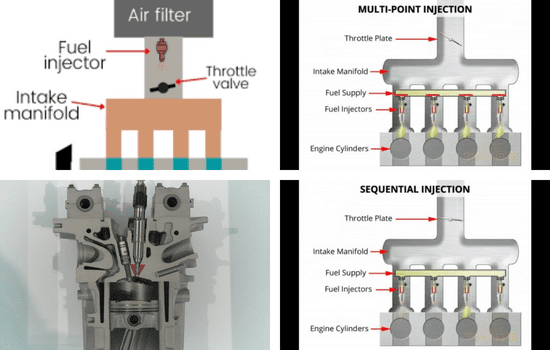Our cars combustion engines would not function without fuel. The fuel injection systems are responsible for delivering this critical fuel into the combustion chambers. Many aspects of your car are heavily influenced by the type of FI system installed in the engine, such as mileage, ride quality, engine life, and so on. A fuel injection system is a mechatronic circuit that combines mechanical and electronic circuits to supply an ideal volume of fuel to the engine.
Because the FI system is such an important component, engineers all over the world have worked to perfect it. While there are many different types of FI systems available today, the broad categorization boils them down to four main types: single point fuel injection, multi-point fuel injection, sequential fuel injection, and direct fuel injection. Let’s go through these categories one by one to see how they work.
Types of Fuel Injection

Throttle-Body Injection or Single-Point Fuel Injection
A single-point injection system uses a single fuel injector for all of the cylinders in the engine’s combustion chamber. This is the most basic and oldest type of FI system. Instead of a carburetor, single-point injection employs one or two injector nozzles in the throttle body, hence the name Throttle body injection (TBI).
The fuel is spray into all cylinders at the same time. But unlike the carburetor jet. It comes from an injector and is monitor by an electronic control unit (ECU).
While it has an advantage over the carburetor. It has a slight disadvantage in that it disturbs engine performance at high RPMs. Although, it is a rough ride quality because the require fuel supply met. Furthermore, a small amount of fuel condenses outside the intake manifold of the cylinders, resulting in fuel waste.
Port injection or multi-point fuel injection
Every cylinder in the combustion chamber of the engine is given as an injector. At the front of their inlet valves (outside the intake port) in multi-point fuel injection (MPFI) technology, which is also known as ‘Port Injection’.
Every injector sprays fuel at the same time, delivering a more precise volume of fuel to each cylinder and reducing the possibility of fuel condensation outside the intake manifold. While MPFI has less fuel waste than TBI. The fuel is spray at the same time in all cylinders. It is not properly sync with the rotation of all the pistons. This causes the fuel to idle in the engine and port for up to 150 milliseconds. Nonetheless, MPFIs perform significantly better than TBIs in terms of performance.
Sequential Fuel injection
The sequential fuel injection system eliminates MPFI’s. It is a disadvantage and is currently the most widely used system. The fuel injectors in a sequential FI system work in relation to the cylinders to which they are connect. Every injector only injects fuel when the cylinder’s intake valve opens. It remains inactive for the remainder of the steps. An ECU monitors cylinder movement and only activates injectors when necessary. Sequential fuel injection is the most effective and efficient system available in the automotive industry today.
Also Read: Best Mileage Bikes In India 2022
Direct injection
In direct fuel injection, the injector is placed inside the cylinder to directly inject fuel. Bypassing the intake valve or manifold.
Type of fuel injection system is most common in diesel engine.
It has a significant presence in petrol engines. Moreover, it is known as a GDI (gasoline direct injection).
Fuel is spray on the intake in the previously mention systems. There is always the possibility of some fuel condensation. However, in the DI system, all of the fuel is directly inject into the cylinder. Resulting in maximum fuel economy and its primary advantage. Direct fuel injection has been used in diesel engines since the 1920s. It has been used in petrol engines since around World War II. Automobile manufacturers have also discovered that GDI engines are more powerful and more convenient for better CNG fuel efficiency.
Pro’s of Fuel Injection
The following are some of the advantages of using fuel-injected engines:
- Throttle response improves, providing the biker with the necessary power at all rpms.
- Cold start issues are almost completely eliminate.
- Longer engine life
- It leads to increased engine efficiency.
- It is also more fuel efficient.
- Cleaner air is produce by more efficient fuel combustion.
- In comparison to carburetors, FI systems require no maintenance and are less prone to failure.
- Air-fuel mixture and atomization accuracy
- ECU mapping makes it simple to tune.
Cons of Fuel Injection
- Fuel injectors are more expensive than carburetors. As a result, there are significant price increases in this BS4 to BS6 transition.
- However, cannot be repair with tool. As a result, it must be replace which is costly.
- Cannot be customize unless custom ECU maps are in use.
- Bike did not start if the ECU fails through where you stuck.
Benefits of a FI system are very obvious despite their high cost. It would still be one of the millions of people who still have faith in the reliable carburetor.
Conclusion
The Fuel injector keeps on evolving because the experiments are all going on to make it better than it is now. The primary objective of fuel injection is to spray fuel in the combustion chamber. An Electronic Control Unit controls the supply of fuel to the combustion chamber (ECU). The ECU tells the injectors how much fuel to inject in order to achieve the most efficient mode of combustion.
It is obvious that fuel injection technology is the present and future of transportation. Carburetors are nearly extinct as a result of the transition from Bharat Stage 4 to direct Bharat Stage 6 emission standards. Even the most basic entry-level motorcycles and scooters now include fuel injectors.
Also Read: Best Car Washer for the Cleaning of your Car




